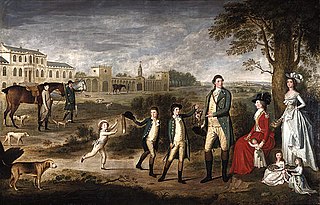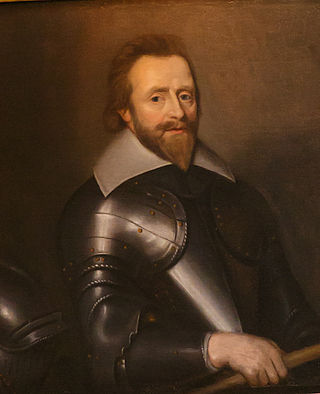
Sir John Anstruther, 4th Baronet and 1st Baronet PC was a Scottish politician.

Sir John Anstruther, 1st Baronet was a Scottish politician who sat in the Parliament of Scotland from 1702 to 1707, and in the British House of Commons from 1708 to 1741.

Sir John Anstruther, 2nd Baronet was a Scottish industrialist and politician.
Major Sir Ralph (Hugo) Anstruther, 7th Baronet was a Scottish British Army officer and courtier.

Lord of Pittenweem or Baron of Pittenweem is a title of nobility in the Baronage of Scotland.

There have been five baronetcies of the United Kingdom created for a person with the surname Erskine, two in the Baronetage of Nova Scotia, one in the Baronetage of Great Britain and two in the Baronetage of the United Kingdom. Two of the creations are extant as of 2010.
There have been three baronetcies created for members of the Glyn family, two in the Baronetage of Great Britain and one in the Baronetage of the United Kingdom.

The Gibson, later Gibson-Carmichael, later Gibson-Craig-Carmichael Baronetcy, of Keirhill in the County of Edinburgh, is a title in the Baronetage of Nova Scotia. It was created on 31 December 1702 for Thomas Gibson, with remainder to his heirs male. The sixth Baronet assumed the additional surname of Carmichael. The eleventh Baronet was a Liberal politician. In 1912, he created Baron Carmichael, of Skirling in the County of Peebles, in the Peerage of the United Kingdom. The barony died in 1926, while he was succeeded in the baronetcy by his kinsman Sir Henry Thomas Gibson-Craig-Carmichael, 5th Baronet, of Riccarton, who became the twelfth Baronet of Keirhill and assumed the additional surname of Carmichael.

There have been eight baronetcies created for persons with the surname Wilson, one in the Baronetage of Ireland and six in the Baronetage of the United Kingdom.

Sir Ian Fife Campbell Anstruther, of that Ilk, 8th Baronet of Balcaskie and 13th Baronet of Anstruther, Hereditary Carver of the Sovereign, Hereditary Master of the Royal Household in Scotland, Chief of the Name and Arms of Anstruther FSA was a baronet twice over. He inherited substantial property interests in South Kensington and wrote several books on specialised areas of 19th-century social and literary history.
Sir Robert Anstruther, 1st Baronet, of Wrae, Linlithgow, and Balcaskie, Fife, was a Scottish politician who sat in the Parliament of Scotland between 1681 and 1707 and in the British House of Commons from 1709 to 1710.
There have been two baronetcies created for members of the Haggerston, later Constable Maxwell-Scott family, one in the Baronetage of England and one in the Baronetage of the United Kingdom. Only one creation is extant as of 2008. The Haggerston, later Constable Maxwell-Scott Baronetcy, of Haggerston in the County of Northumberland, was created in the Baronetage of England on 15 August 1642 for Thomas Haggerston, of Haggerton Castle, Northumberland, a loyal Royalist who served as a colonel in the army of King Charles I. The Haggerston were recusant in the 17th century and the estates were sequestered and forfeit to the Commonwealth of England in 1649 but were repurchased by the first Baronet in 1653. The line of the fourth Baronet failed on the death of the twelfth Baronet in 1972. The title reverted to the line of William Haggerston, second son of the third Baronet and younger brother of the fourth Baronet. In 1746 he inherited estates in Yorkshire from his great-uncle Sir Marmaduke Francis Constable, 4th and last Baronet, of Everingham, and assumed the surname of Constable in lieu of his patronymic. In 1758 he married Winifred, daughter of Robert Maxwell, titular sixth Earl of Nithsdale, and assumed by Royal licence the additional surname of Maxwell. Winifred was considered to be the heiress to the Scottish lordship of Herries of Terregles held by her father. Constable-Maxwell built a new house at Everingham Park on the Constable estate in Yorkshire.

There have been four baronetcies created for members of the ancient House of Beaumont, all in the Baronetage of England. All four creations are extinct or dormant.

There have been two baronetcies created for members of the Coote family. The first is Coote of Castle Cuffe, while the second is Coote of Donnybrooke, both in the Baronetage of Ireland. As of 2020, the first creation is still extant. The holders of the first creation also held the title of Earl of Mountrath between 1660 and 1802.
Sir Windham Charles James Carmichael-Anstruther, 8th Baronet and 4th Baronet DL was a Liberal Party politician and Scottish baronet.

There have been two baronetcies created for members of the Pryse family, one in the Baronetage of England and one in the Baronetage of the United Kingdom. Both creations are extinct.
Anstruther Wester in Fife was a royal burgh, created in 1587, that returned one commissioner to the Parliament of Scotland and to the Convention of Estates.

Sir Philip Anstruther, 2nd Baronet of Balcaskie, Fife was a Scottish advocate and landowner.

Sir Robert Anstruther, 3rd Baronet of Balcaskie, Fife was a Scottish advocate and landowner.
SirThomas Hope, 8th Baronet was a Scottish aristocrat, lawyer and agricultural reformer.













